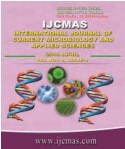


 National Academy of Agricultural Sciences (NAAS)
National Academy of Agricultural Sciences (NAAS)

|
PRINT ISSN : 2319-7692
Online ISSN : 2319-7706 Issues : 12 per year Publisher : Excellent Publishers Email : editorijcmas@gmail.com / submit@ijcmas.com Editor-in-chief: Dr.M.Prakash Index Copernicus ICV 2018: 95.39 NAAS RATING 2020: 5.38 |
A field experiment was conducted at College of Horticulture, Venkataramannagudem, West Godavari district, Andhra Pradesh during late kharif season of 2010 with an objective to evaluate the package of organic and biological sources of nutrients vis-à-vis inorganic fertilizers on yield, quality and economics of ashwagandha. The experiment was laid out in randomized block design with fourteen treatments replicated thrice. The treatments consisted of nutrients from different organic sources Viz., Neem cake, vermicompost, poultry manure, farm yard manure, sunnhemp in situ green manure, biological sources viz., Azospirillum + PSB alone and in combination with organic sources of nutrients and inorganic sources viz., recommended dose of fertilizers (N P K at 40:60:20 kg ha 1) and 50 % recommended dose of fertilizers (N P K at 20:30:10 kg ha-1). The study revealed that application of Poultry manure + Biofertilizers (Azospirillum + PSB) produced longest roots (21.00 cm) with widest diameter (1.59 cm) but was on par with vermicompost + biofertilizers and recommended dose of inorganic fertilizers. The same treatment i.e., Poultry manure + Biofertilizers recorded maximum fresh root (1524 kg ha-1), dry root (739 Kg ha-1) and seed yield (186.4 kg ha 1) but was on par with vermicompost + biofertilizers and recommended dose of inorganic fertilizers. Similar trend was observed in respect of total alkaloid content of roots. The treatment poultry manure + Biofertilizers also recorded maximum gross (Rs 96,202) and net income (Rs 72,252) but B:C ratio was maximum in recommended dose of fertilizers (3.12) followed by Poultry manure + Biofertilizers. Thus, Poultry manure + Biofertilizers with overall better performance and economic advantage over other treatments can be recommended for complete substitution of inorganic fertilizers in ashwagandha.
 |
 |
 |
 |
 |